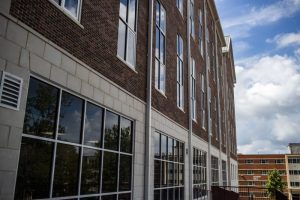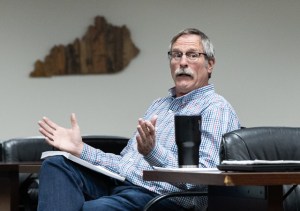America’s religious poor portrayed in photography display
Published 12:00 am Saturday, December 16, 2000
University of Utah history and religious studies Professor Dr. Colleen McDannell speaks about religious photography Monday at Western Kentucky University. Dorothea Langes famous Migrant Mother picture is in the background. Photo by Clinton Lewis
Black-and-white pictures of Americas rural religious poor and the story of their lives drew a crowd of more than 200 Monday night at the Kentucky Museum. Colleen McDannell, professor of history and religious studies at the University of Utah, told the crowd of mostly Western Kentucky University students about the lives of the photographers and the people in the pictures at the museums current exhibit, Picturing Faith. The exhibits black-and-white photos were selected by McDannell and are part of a collection of 270,000 pictures archived by the Library of Congress. Thirty photographers employed by the Farm Securities Administration from 1935 to 1943 took the pictures to document social conditions in America. A selection of photographs produced by the historical section of the Farm Security Administration has achieved the status of cultural emblems in the American imagination, McDannell said. From college text books to television programs, images such as Dorothea Langes Migrant Mother are employed as well-known reminders of the Depression and the New Deal. The 45 photographs McDannell chose for her exhibit examine the relationship between photography and religion. To document the decaying social conditions of rural America, photographers focused on unskilled labor, migrant problems, poor housing and environmental decay, McDannell said. The FSA photographers ignored evidence of local cultural vigor and instead displayed rural Americans as the most friendless, hopeless people in the whole country. Roy Stryker, the chief of the division of information for the Farm Security Administration, instructed photographers to take pictures of religious leaders, behaviors, buildings and objects. Stryker understood that religion was an integral part of American culture, McDannell said, adding that religion was not an important part of Strykers life. McDannell chose certain photographs for her presentation and examined the question of whether photographers influenced their subjects or vice-versa. A photograph by Gordon Parks showing a black minister dressed in a cape staring boldly into the camera is an example of the contrast between photography of the pre-magazine world and the endless succession of pictures by todays photographers, McDannell said. These photographs have a historical meaning because they are disciplined and restrained, she said. That has allowed them to have an enduring character. Many of the FSA photographers had no religious commitment and McDannell questioned if they could sufficiently photograph the spirit of the deeply religious rural Americans. Photography is a dance, she said. I feel like as a historian, it is important for me to listen to them and also listen to what the photographers were imposing on them. Its a two-way street. Western sophomore Liza Tichenor said she feels like the photographers works were unbiased. They did a good job of portraying life, she said. Not the actions, but the elements. The Picturing Faith exhibit was brought to the museum by Larry Snyder, associate professor of philosophy and religion at Western. Its a wonderful exhibit for anyone who is interested in photography, American history, folk life or journalism, he said. It is a very interesting way of doing history. We spend an awful lot of time reading books, but religion in history is not about just books, its about the way people lived their lives. These photos are literally snapshots in time, said John Long, the head of Westerns religious departmentPicturing Faith opened Oct. 1 and will run though Nov. 25. Price of admission is a $2 for adults and a $1 for children. The exhibit is free on Sundays. The museum is closed on Monday. It is open from 9:30 a.m. to 4 p.m. Tuesday though Saturday and 1 p.m. to 4 p.m. Sunday.







